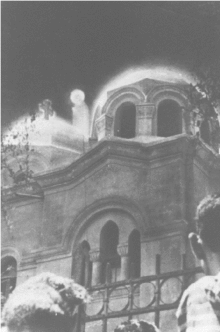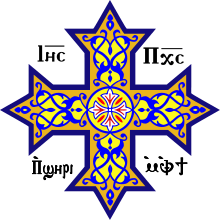Our Lady of Zeitoun
Our Lady of Zeitoun, also known simply as El-Zeitoun, Zeitun or rarely Our Lady of Light, was a mass Marian apparition that occurred in the Zeitoun district of Cairo, Egypt, over a period of 2–3 years beginning on April 2, 1968.
| Our Lady of Zeitoun | |
|---|---|
 A photo of the Virgin Mary above the Church of Virgin Mary in Zeitoun, Cairo | |
| Location | Zeitoun, Cairo, Egypt |
| Date | April 2nd, 1968 |
| Type | Marian Apparition |
| Approval | Coptic Orthodox Church |
| Patronage | Egypt |
Apparition
The first apparition at Zeitoun was recorded on the evening of April 2, 1968, when a Muslim bus mechanic named Farouk Mohammed Atwa, who worked across the street from St. Mary's Coptic Church in Zeitoun, supposedly thought he saw a woman attempting suicide by jumping from the structure. Two other men also noticed a white figure on the top of the church[1] and the sighting was reported to the police.[2] A crowd gathered on the site and the police attempted to disperse it. According to the police, the sighting was just a reflection of the light from the street lamps.[2] However, the crowds reportedly viewed the sighting as a clear apparition of the Virgin Mary, and so, the attempts by the police to disperse the crowd were unsuccessful.[2] The event itself ended after a few minutes.
One week later on April 9 the phenomenon reoccurred, again lasting for only a few minutes. After that time apparitions became more frequent, sometimes two-three times a week, for several years, ending in 1971.[2] According to Coptic tradition, the site is one of the locations where the Holy family stayed during their flight into Egypt.
The head of the Coptic Orthodox Church of Alexandria, Pope of Alexandria, Kyrillos VI appointed a committee of high-ranking priests and bishops to investigate the matter, headed by Bishop Gregorios, bishop of postgraduate studies, Coptic culture and scientific research.[3] On May 4 Kyrillos VI issued an official statement confirming the apparitions.[4]
Nuns of the Society of the Sacred Heart also witnessed the apparitions and sent a detailed report to the Vatican, resulting in the arrival of an envoy on April 28 who also saw the apparitions and sent a report to Pope Paul VI. As the apparition appeared over a Coptic church, the Vatican left the investigation to the Coptic authorities. On May 5, 1968, Coptic Orthodox Pope Kyrillos VI approved the apparition.
The apparitions were also witnessed by President Gamal Abdel Nasser,[5] and captured by newspaper photographers and Egyptian television. Investigations performed by the police could find no explanation for the phenomenon. No device was found within a radius of fifteen miles capable of projecting the image, while the sheer number of photographs from independent sources suggests that no photographic manipulation was involved. Having been unable to produce an alternative explanation for the luminous sightings, the Egyptian government accepted the apparitions as true.[6]
Golden Jubilee
On 12 May 2018, the Coptic Church celebrated the golden Jubilee of the event.[7] Pope Tawadros II held the four Holy Mass.[8] A large number of priests and Christians from all over Egypt attended the celebration, Sub-celebrations have been held from May 10 to May 13.[9][10][11]
See also
- Church of the Virgin Mary (Zeitoun)
- Our Lady of Warraq
- Our Lady of Assiut
- Coptic Orthodox Church
References
- Carroll, Michael P. (1992), The cult of the Virgin Mary: psychological origins, Princeton University Press, pp. 211–212, ISBN 0-691-02867-2
- Michael P. Carroll The cult of the Virgin Mary: psychological origins, p. 212
- "The Apparitions Of The Blessed Holy Virgin Mary"
- Bishop Grigorius (1968), ST. MARY'S TRANSFIGURATIONS (The Coptic Orthodox Church of Zeitun), Cairo: Dar Memphis Press, pp. 16–18
- LaFave, Peter. "When Mary Returned to Egypt", The Christian Review, 21 January 2016
- Johnston, Francis. When Millions Saw Mary. Augustine Publishing Co., 1980 ISBN 0-85172-631-3
- https://www.youm7.com/story/2018/5/10/الكنيسة-تبدأ-اليوم-الاحتفال-باليوبيل-الذهبى-لظهور-العذراء-بكنيسة-الزيتون/3785989
- https://www.youm7.com/story/2018/5/12/البابا-تواضروس-يترأس-صلوات-عشية-الاحتفال-بظهور-العذراء-فى-الزيتون/3789967
- "اليوم.. 4 قداسات للاحتفال باليوبيل الذهبي لتجلي العذراء مريم".
- "الأقباط متحدون - شاهد.. الاحتفال باليوبيل الذهبي لظهور العذراء مريم".
- "Archived copy". Archived from the original on 2018-07-02. Retrieved 2018-05-12.CS1 maint: archived copy as title (link)
Further reading
- Pearl Zaki (1977). Our Lord's Mother visits Egypt in 1968 & 1969. Publisher Dar el Alam el Arabi. Available online
- Francis Johnston (1980). When Millions Saw Mary. Augustine Publishing Co. ISBN 0-85172-631-3 also available online
- Youssef G. Kamell/ John P. Jackson/ Rebecca S. Jackson (1996): A Lady of Light Appears in Egypt. The story of Zeitoun. St. Mark's Avenue Press.
- Père Francois Brune (2004): La Vièrge de l'Egypte. L'incroyable apparition de Marie à des millions d'Egyptiens. Editions Le jardin des Livres.
- Articles "Caire III - Caire X", in: Laurentin, René / Sbalchiero, Patrick (eds.)(2007): Dictionnaire des "apparitions" de la Vierge Marie. Fayard.
